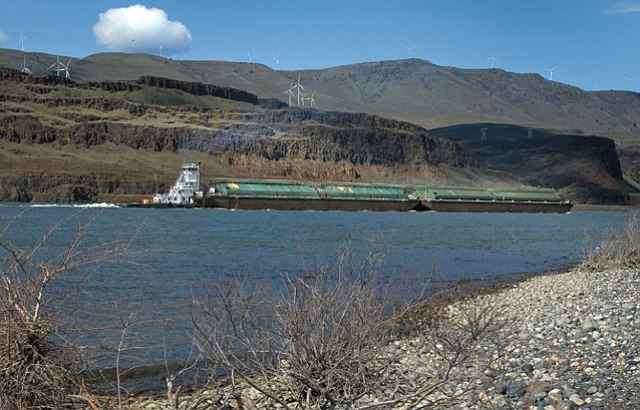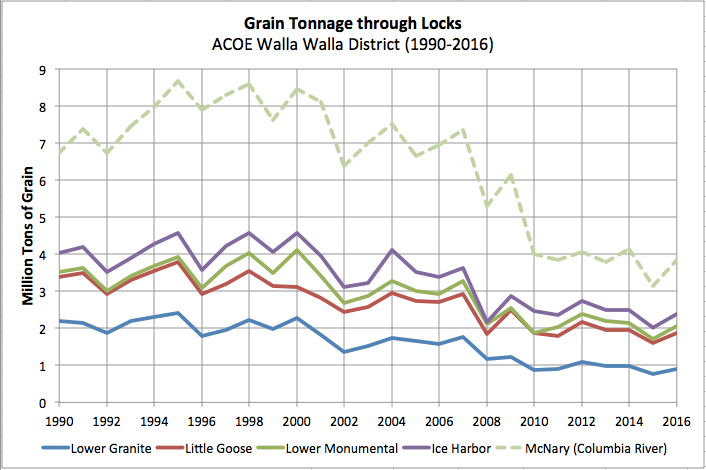forum
library
tutorial
contact

Congressional Effort to Blunt
Dam Breaching Effort is Sound
by Editorial Board
Walla Walla Union-Bulletin, July 7, 2017
|
the film forum library tutorial contact |

|
Congressional Effort to Blunt
by Editorial Board
|
Tearing down the four Snake River dams would be a disaster for the region.
 Taking action to protect salmon runs in the Snake River makes sense. But an option that is simply not realistic or prudent at this time is breaching the dams on the Snake.
Taking action to protect salmon runs in the Snake River makes sense. But an option that is simply not realistic or prudent at this time is breaching the dams on the Snake.
Given that, the legislation proposed by U.S. Rep. Cathy McMorris Rodgers, R-Spokane, U.S. Rep. Dan Newhouse, R-Sunnyside, and other legislators to protect the dams from a federal judge's overzealous views make sense. The proposal would keep in place the Federal Columbia River Biological Opinion (FCRPS), until 2022. It's a plan created by a collaboration of federal agencies, states and tribes to protect salmon while operating dams.
"Hydropower provides 70 percent of our energy in Washington state -- much of which is produced on the Federal Columbia River Power System," said McMorris Rodgers. "The FCRPS ensures people in Eastern Washington have access to clean, renewable, reliable, and affordable energy every single day -- all while achieving record fish returns. There is still work to be done, but dams and fish can coexist, and the FCRPS proves that."
According to the Tri-City Herald, the proposed legislation would effectively overturn an April decision by Judge Michael Simon that would require the Army Corps of Engineers to spill more water for fish at eight Columbia and Snake river dams starting next year. In addition, Simon requires that taking down the dams be considered.
Along with the reduction of the generation of hydroelectric power, spilling too much water creates high gas levels in the water that can harm juvenile fish.
The effort to ensure salmon survival must consider the overall impact to the environment, the economy and our lives.
Tearing down the four Snake River dams would be a disaster for the Pacific Northwest. The water from a free-flowing Snake would flood farms, roadways, homes and even cities. But the action would not necessarily be a boon to salmon runs.
(bluefish notes: the four Lower Snake River dams are run-of-river dams, not storage dams, nor is flood control recognized as one of their purposes. The town of Lewiston, Idaho is protected against flooding by an ACOE constructed levy, with plans conducted to raise the levy yet higher as sediment accumulates annually at the head of the 40-mile-long reservoir impounded by Lower Granite Dam.)
 It is unrealistic to believe the hands of time can be turned back.
It is unrealistic to believe the hands of time can be turned back.
Dam breaching has been studied, studied and then studied some more. A 2001 study by the U.S. Army Corps concluded breaching the Ice Harbor, Lower Monumental, Little Goose and Lower Granite dams would increase the chances of salmon restoration only slightly -- if at all -- while significantly hurting the Pacific Northwest's economy.
(bluefish notes: The $30 million dollar ACOE study did not find negative economic effects to the NW economy but rather found both long-term and short-term economic benefits. The Editors here may be mistaking the value of lost electricity production as "significantly hurting the NW economy". However, the NW continues to have a large power surplus, with around one-quarter of the annual federal hydropower being sent down powerlines to California, a state that is increasingly becoming energy independent, recently experiencing its own power surplus due to its ongoing promotion of renewable wind and solar energy solutions.)
Crops and other goods could no longer be barged down the river, forcing the products to be hauled by trucks on the roadways. Boosting the truck traffic would be environmentally irresponsible.
(bluefish notes: Shipping of wheat from Lewiston/Clarkston amounts to less than 1.5 million bushels per year (see Total Tonnage through Lockage, ACOE data. This quantity doubles to around 3 million bushels midway down the Lower Snake. With dam breaching, this movement of grain will move to train rather than truck as suggested by the author here states. Fear of rail rates increasing with the end of the subsidized barge transportation is, however, a legitimate concern.)
About 3,700 farmers grow wheat and barley in the region, most of which is shipped to Portland to be exported overseas. A tug pushing a barge can haul a ton of wheat 576 miles on a single gallon of fuel.
The loss of hydropower would also be a blow to the environment.
The dams are in place, they serve a critical purpose and they must remain.
Related Pages:
Congressional Effort to Blunt Dam Breaching Effort is Sound by Editorial Board, Walla Walla Union-Bulletin, 11/30/16
Snake River Dams Are Assets That Must Remain by Ron Dunning, Walla Walla Union-Bulletin, 3/28/15
Adult Salmon Survival Past Dams is 99 Percent by John McKern, Walla Walla Union-Bulletin, 3/25/15
Fish Survival Rate is Disputed by Borg Hendrickson, Walla Walla Union-Bulletin, 3/21/15
Idaho Needs and Can Maintain Both Its Dams and Fish by David Doeringsfeld, Lewiston Tribune, 3/15/15
Hydropower Not Been Replaced by Wind Power by John McKern, Walla Walla Union-Bulletin, 3/6/15
Lower Snake River Dams Are Economic Losers by Borg Hendrickson, Walla Walla Union-Bulletin, 2/28/15
Blaming Dams for Fish Loss is a Hoax by John McKern, Walla Walla Union-Bulletin, 8/23/13
Dams are More Valuable Than Some Want to Believe by Louis G. Valiante, Walla Walla Union-Bulletin, 7/1/12
Removing the Snake River Dams is a Really Stupid Idea by Aaron Bennett, Walla Walla Union-Bulletin, 12/20/11
Breaching Dams on Snake River is Foolish Idea by Editorial Board, Walla Walla Union-Bulletin, 8/22/9
Judge's Action on Salmon Case Show Need to Find New Judge by Editorial Board, Walla Walla Union-Bulletin, 9/25/8
Breaching Snake River Dams is Action of Last Resort by Editorial Board, Walla Walla Union-Bulletin, 5/28/7
learn more on topics covered in the film
see the video
read the script
learn the songs
discussion forum
